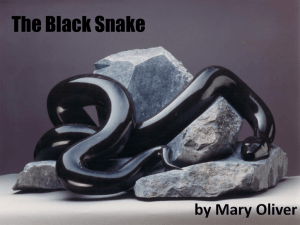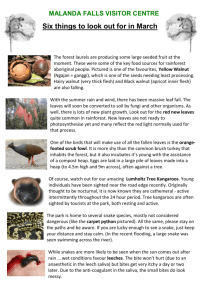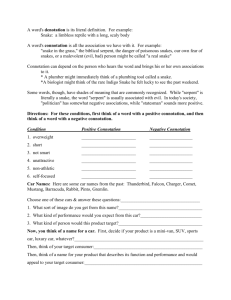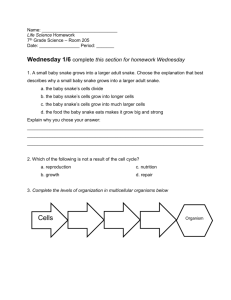Contents
advertisement
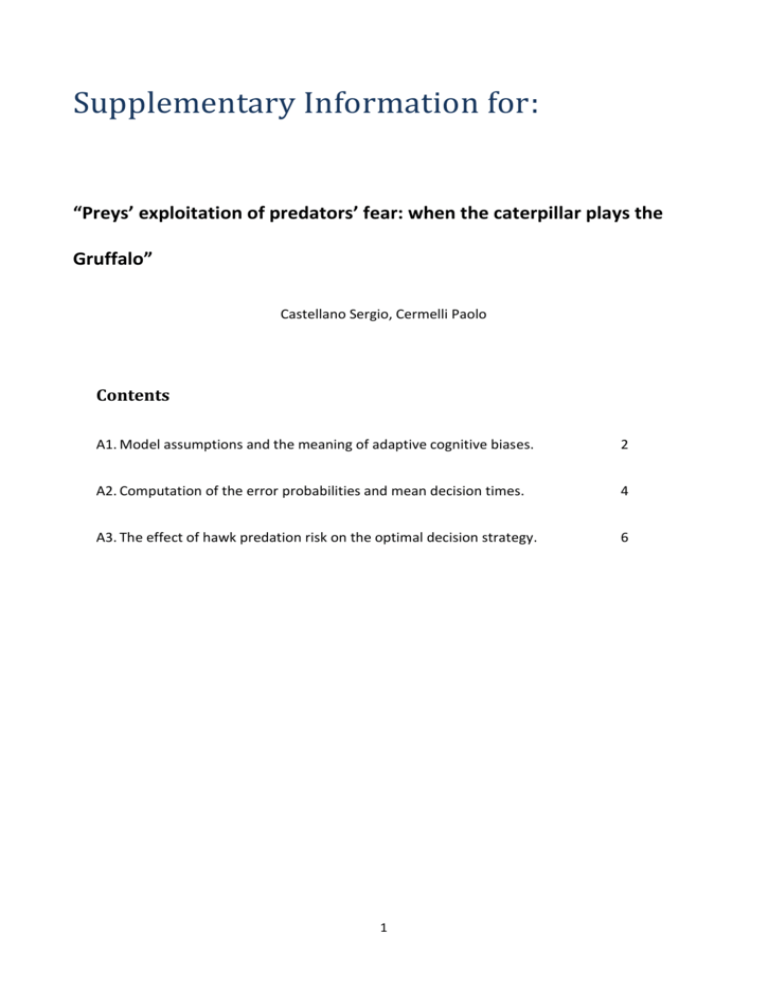
Supplementary Information for:
“Preys’ exploitation of predators’ fear: when the caterpillar plays the
Gruffalo”
Castellano Sergio, Cermelli Paolo
Contents
A1. Model assumptions and the meaning of adaptive cognitive biases.
2
A2. Computation of the error probabilities and mean decision times.
4
A3. The effect of hawk predation risk on the optimal decision strategy.
6
1
A1.
Model assumptions and the meaning of adaptive cognitive
biases
In our model, the decision maker (the bird) is uncertain about the true nature of the inspected animal, but
it has a “complete knowledge” about such an uncertainty, in that the bird is assumed to make decisions as
he knew the conditional probability density functions that the inspected animal is (or is not) either a
caterpillar or a snake. At first sight, this might seem a strong as well as improbable assumption. However,
as it has been first suggested by Castellano (2015), the bird does not need to have an internal
representation of these probability distributions, but just a neural linear filter, which converts the sensory
input into perceived evidence (see Figure S1). This filter might have been set through learning during an
individual lifetime or genetically over evolutionary time.
For this reason, the model assumes that the bird has an unbiased perception of the nature of the perceived
stimuli and that the mechanism that skews the response errors involves only the decision rule (the decision
threshold). Indeed, the bird is more likely to confound a caterpillar for a snake than vice versa simply
because it adopts different decision thresholds for prey and predator recognition. We call the asymmetry in
the decision thresholds an ‘adaptive cognitive bias’, because it is ‘the mechanism that allows decision
agents to adjust their decision rules to the internal and external conditions they are facing’ (Castellano
2015, but see Johnson et al. 2013 and Marshall et al. 2013 for a contentious interpretation of adaptive
cognitive bias). This definition focuses on the mechanism of information processing and, in fact, our model
makes specific assumptions about the way information is processed, but it makes no assumptions about
the way information is perceived. The bird that mistakes a caterpillar for a snake may actually “see” a snake
in the caterpillar and experience “irrational” fear, or it may perceive uncertainty and “rationally” decide
that further assessment is not worthy, or it may behave as our stochastic decision variable in one of the
thousands of simulations we carried out, which simply obeys to the rules implemented by the program
without any perception of what is going on. Whatever the meaning (if any) that the decision maker assigns
to the acquired information, the mechanism of information processing introduces a bias in decision making,
which makes some behaviours more likely than others. We call this bias an adaptive cognitive bias.
References.
Castellano S, 2015 Bayes' rule and bias roles in the evolution of decision making. Behav. Ecol. 26, 282–292.
doi: 10.1093/beheco/aru188.
Johnson DDP, Blumstein DT, Fowler JH, Haselton MG, 2013 The evolution of error: error management,
cognitive constraints, and adaptive decision-making biases. Trends Ecol. Evol. 28, 474–481. doi:
10.1016/j.tree.2013.05.014.
Marshall JAR, Trimmer PC, Houston AI, McNamara JM, 2013 On evolutionary explanations of cognitive
biases. Trend Ecol. Evol. 28, 469—473.
2
Figure S1. The bird’s Snake S-module converts sensory information into snakeness scores. When
inspecting a prospective prey, the bird is assumed to collect several pieces of information, whose
frequencies are distributed according to two normal curves, with similar variance and different mean: if the
inspected animal is a snake, the pieces of evidence follow the red curve (i.e. 𝑓𝑠𝑛𝑎𝑘𝑒 (𝑥) = 𝑃(𝑥|𝐻 𝑠 )), if it is
not a snake, but either a caterpillar or a millipede, they distribute along the blue curve (i.e. 𝑓𝑛𝑜𝑡−𝑠𝑛𝑎𝑘𝑒 (𝑥) =
𝑃(𝑥|𝐻 𝑐,𝑚 )). When a single piece of evidence reaches the S-module, it is converted in a snakeness score by
the linear filter g(x), which is the log-ratio of the two normal curves.
3
A2.
Computation of the error probabilities and mean decision
times.
In this section we detail the procedure that we have used to compute the error probabilities 𝛼𝑐𝑠 and 𝛼𝑐𝑚 of
mistaking a caterpillar by a snake or a millipede, the probabilities 𝛼𝑠𝑐 and 𝛼𝑠𝑚 of mistaking a snake by a
caterpillar or a millipede, as well as the expected decision times ts, tc and tm for snakes, caterpillars and
millipedes. First of all, assuming that the number of samples is very high, we can replace the random walks
in EQ. 1 (see main text) by two 2-dimensional diffusion processes in the (Vs,Vc)-plane [1,2], given by
𝑑𝑉 𝑠 (𝑡) = 𝜇 𝑠 𝑑𝑡 +
2d
𝑑𝑊(𝑡),
𝜎
𝑑𝑉 𝑐 (𝑡) = 𝜇𝑐 𝑑𝑡 +
and
2d
𝑑𝑊(𝑡),
𝜎
where t is time, Vs=(Vss,Vsc) and Vc=(Vcs,Vcc) are the vectors of accumulated evidence under the
hypotheses Hs and Hc, respectively, i.e., when the signal is emitted by a snake or by a caterpillar,
s=(2d2/2, -2d2/2), c=(-2d2/2, 2d2/2) are the drift vectors under the hypotheses Hs and Hc,
respectively, and W(t) is 2-dimensional Brownian motion. The assumption that there is no correlation
between the snake and the caterpillar components of the signal, i.e., that the covariance matrices are
diagonal, is not restrictive: writing Rs and Rc for the covariance matrices under the hypotheses Hs and Hc,
respectively, yields
𝑑𝑉 𝑠 (𝑡) = 𝜇 𝑠 𝑑𝑡 + 𝑍 𝑠 𝑑𝑊(𝑡), and
𝑑𝑉 𝑐 (𝑡) = 𝜇𝑐 𝑑𝑡 + 𝑍 𝑐 𝑑𝑊(𝑡),
with (Zs)2= Rs and (Zc)2 = Rc. Hence, a correlation between the components of the signal would not affect
the drift, but, according to the sign, would reduce or increase the fluctuations of the perceived signal and
in turn, the perception error.
For each decision strategy (𝑎𝑠 ; −𝑏𝑠 ; 𝑎𝑐 ; −𝑏𝑐 ), the region of the decision plane lying within these thresholds
is an unbounded elbow-shaped region: hence, in order to bound decision times, we assign an additional
lower threshold 𝑙 such that when either 𝑉𝑠 or 𝑉𝑐 are below 𝑙 the bird concludes that the signal
corresponds to a millipede (Fig. 1). Let
𝛺 = {(𝑉𝑠 , 𝑉𝑐 ): −𝑏𝑠 ≤ 𝑉𝑠 ≤ 𝑎𝑠 , −𝑏𝑐 ≤ 𝑉𝑐 ≤ 𝑎𝑐 }
∪ {(𝑉𝑠 , 𝑉𝑐 ): −𝑏𝑠 ≤ 𝑉𝑠 ≤ 𝑎𝑠 , −𝑙 ≤ 𝑉𝑐 ≤ −𝑏𝑐 }
∪ {(𝑉𝑠 , 𝑉𝑐 ): −𝑙 ≤ 𝑉𝑠 ≤ −𝑏𝑠 , −𝑏𝑐 ≤ 𝑉𝑐 ≤ 𝑎𝑐 }
be the uncertainty domain, and
𝛴 = {(𝑉𝑠 , 𝑉𝑐 ): 𝑉𝑠 = 𝑎𝑠 , −𝑏𝑐 ≤ 𝑉𝑐 ≤ 𝑎𝑐 } ⊂ 𝜕𝛺,
𝛤 = {(𝑉𝑠 , 𝑉𝑐 ): −𝑏𝑠 ≤ 𝑉𝑠 ≤ 𝑎𝑠 , 𝑉𝑐 = 𝑎𝑐 } ⊂ 𝜕𝛺,
𝑀 = {(𝑉𝑠 , 𝑉𝑐 ): 𝑉𝑠 = −𝑏𝑠 , −𝑙 ≤ 𝑉𝑐 ≤ −𝑏𝑐 } ∪ {(𝑉𝑠 , 𝑉𝑐 ): −𝑙 ≤ 𝑉𝑠 ≤ 𝑏𝑠 , 𝑉𝑐 = −𝑏𝑐 } ⊂ 𝜕𝛺
be the acceptance thresholds for snake, caterpillar and millipede, respectively. Finally, for 𝑋 ∈ 𝛺,
𝑋
𝑋
let 𝜏𝑠,𝜕𝛺
= 𝑖𝑛𝑓{𝑡: 𝑉 𝑠 (𝑡) ∈ 𝜕𝛺, 𝑉 𝑠 (0) = 𝑋} and 𝜏𝑐,𝜕𝛺
= 𝑖𝑛𝑓{𝑡: 𝑉 𝑐 (𝑡) ∈ 𝜕𝛺, 𝑉 𝑐 (0) = 𝑋} be the first exit
times of each process from 𝜕𝛺. The first exit time is a random variable that depends on the realization of
the stochastic process V(t) starting at X. The probability that a specific decision is taken for a signal with
4
initial value X is the probability that the first exit of the diffusion process from occurs at the
corresponding threshold boundary. More precisely, the functions
𝑋
𝜑𝑠𝑐 (𝑋) = 𝑃𝑟𝑜𝑏[𝑉 𝑠 (𝜏𝑠,𝜕𝛺
) ∈ 𝛤]
𝑋
𝜑𝑠𝑚 (𝑋) = 𝑃𝑟𝑜𝑏[𝑉 𝑠 (𝜏𝑠,𝜕𝛺
) ∈ 𝛭]
and
are the probabilities that a snake with initial signal X is mistaken by a caterpillar or a millipede respectively.
Analogous definitions hold for the error probabilities of a caterpillar signal, 𝜑𝑐𝑠 (𝑋), 𝜑𝑐𝑚 (𝑋). Classical results
guarantee that, for instance, the probability 𝜑𝑠𝑐 (𝑋)is the solution of the boundary value problem
1 4d2
𝛥𝜑𝑠𝑐 + 𝜇𝑐 ⋅ 𝛻𝜑𝑠𝑐 = 0 in 𝛺
2 𝜎2
𝜑𝑠𝑐 = 1
on 𝛤
on 𝜕𝛺 − 𝛤
{𝜑𝑠𝑐 = 0
similar formulas holding for the other probabilities. Solving the PDEs by finite differences methods allows
to determine numerically the error probabilities. Knowing these, we can compute the error probabilities as
𝛼𝑠𝑐 = 𝐸(𝜑𝑠𝑐 ∣ 𝐻 𝑠 ),
𝛼𝑠𝑐 = 𝐸(𝜑𝑠𝑚 ∣ 𝐻 𝑠 ),
𝛼𝑐𝑠 = 𝐸(𝜑𝑐𝑠 ∣ 𝐻 𝑐 ),
𝛼𝑐𝑚 = 𝐸(𝜑𝑐𝑚 ∣ 𝐻 𝑐 ),
where E( . |H) denotes conditional expectation.
As to the decision times, these can be identified to the expected first exit times from , i.e., letting
𝑋
𝜓𝑠 (𝑋) = 𝐸 𝑋 [𝜏𝑠,𝜕𝛺
],
𝑋
𝜓𝑐 (𝑋) = 𝐸 𝑋 [𝜏𝑐,𝜕𝛺
],
𝑋
𝜓𝑚 (𝑋) = 𝐸 𝑋 [𝜏𝑚,𝜕𝛺
],
for the mean decision time for a snake, caterpillar or millipede signal starting at X, these are solutions of
boundary value problems of the kind
1 4d2
{2 𝜎 2 𝛥𝜓𝑠 + 𝜇𝑐 ⋅ 𝛻𝜓𝑠 = −1 in 𝜕𝛺
𝜓𝑠 = 0
on 𝜕𝛺
similar formulas holding for 𝜓𝑐 (𝑋), 𝜓𝑚 (𝑋). The solutions can again be determined numerically, which
allows to compute the expected decision times as
𝑡𝑠 = 𝐸(𝜓𝑠 ∣ 𝐻 𝑠 ),
𝑡𝑐 = 𝐸(𝜓𝑐 ∣ 𝐻 𝑐 ),
𝑡𝑚 = 𝐸(𝜓𝑚 ∣ 𝐻 𝑚 ).
References.
1. Karatzas I, Shreve S, 1998 Brownian motion and stochastic calculus. New York, USA: Springer.
2. Oksendal B., 2003 Stochastic differential equations, New York, USA: Springer.
5
A3.
The effect of hawk predation risk on the optimal decision
strategy.
Here we analyse the effects of hawk predation, by keeping snake predation constant at 𝜗𝑠 = 0.1. When
the hawk predation risk is very low, the bird is not constrained by the time spent searching for caterpillars
and he minimizes snake predation by keeping a very low snake top threshold (filled circles) and a very high
caterpillar top threshold (open circles) (as shown in panel a). This decisional strategy minimizes the
probability of false-negatives in snake recognition (panel b), but exposes the bird to a high rate of falsenegatives in caterpillar recognition and, consequently, it increases the expected number of inspected
animals (panel c). As the hawk-predation risk increases, the difference between the snake and the
caterpillar top thresholds decrease, causing a slight increase in snake false-negatives and a marked
decrease in caterpillar false-negatives, which result in a reduction of the number of prospective preys
inspected by the bird. In these simulations, the parameters are the following:
Figure S2. The effect of the hawk predation risk.
6



